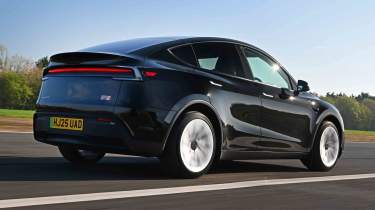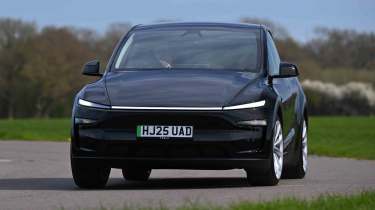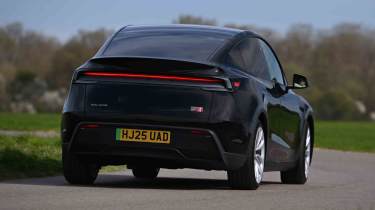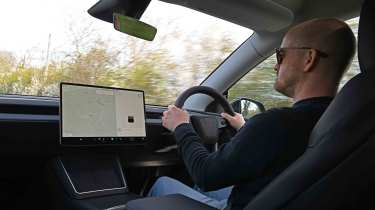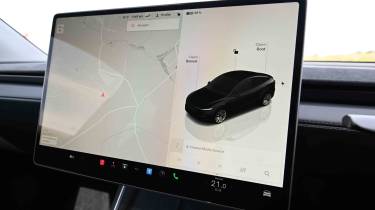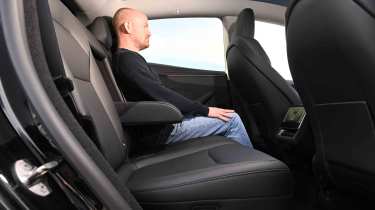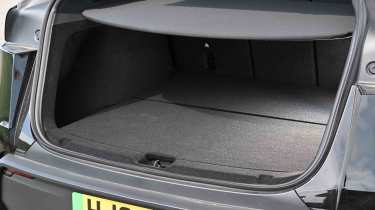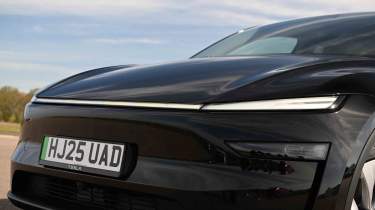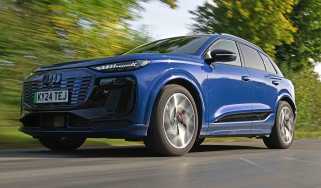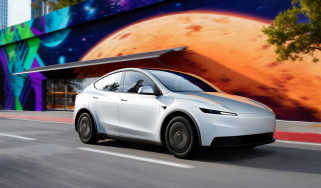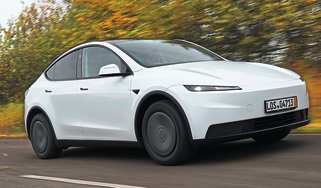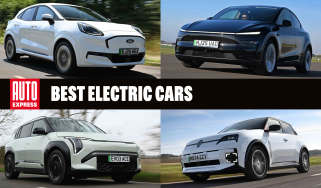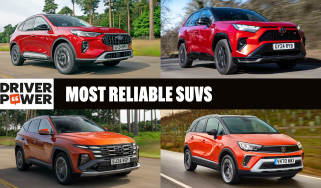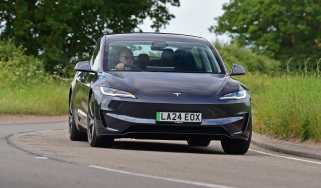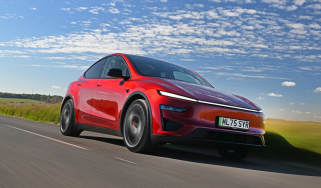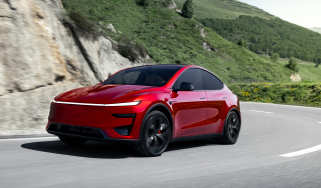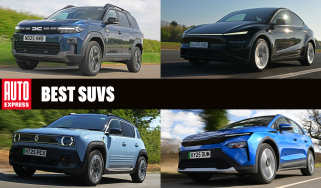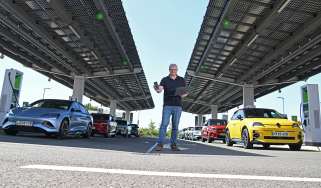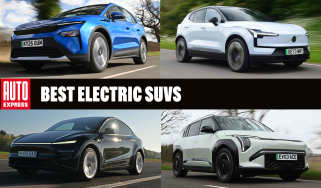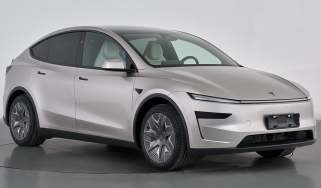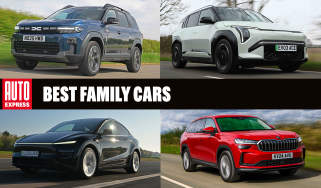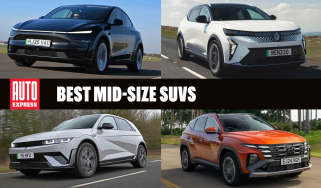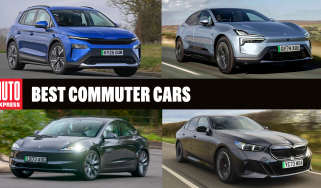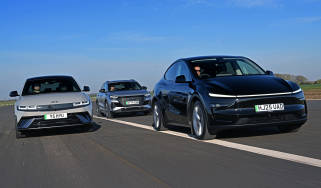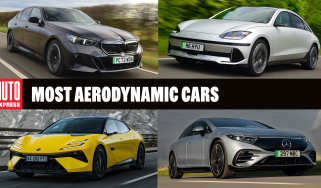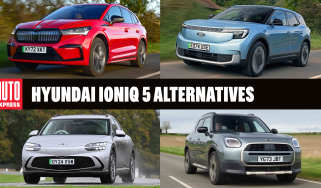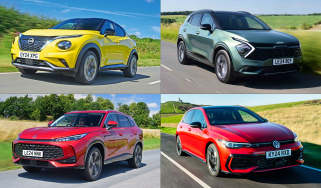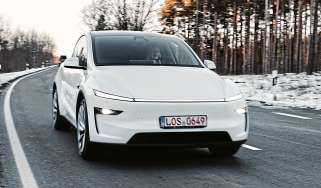Tesla Model Y review
The Model Y remains hugely popular, and our tests have consistently shown it’s one of the easiest EVs to own

Our opinion on the Tesla Model Y
While CEO Elon Musk divides opinion, there’s no doubt that the Tesla Model Y is one of the most popular and best EVs that’s currently available to buy. It was good before, but Tesla’s engineers made a series of notable improvements to the car in 2025, improving matters further.
The new touchscreen-only controls won’t be for everyone, and we’d like a few more physical buttons for key features to help with day-to-day driving. Both the ride and handling have been improved, while battery efficiency remains a big strong point. Combine all this with Tesla’s market-leading Supercharger network, and the Model Y will continue to make a lot of sense for a lot of buyers. It’s simply one of the most rounded electric SUVs available on today’s market.
About the Tesla Model Y
With the Tesla Model Y, the US company introduced a car that was just right for so many UK buyers’ demands. Sure enough, Tesla’s creation was the fifth best selling car in the UK in 2024 and the best selling electric car overall.
The mid-size SUV is based on the same running gear as the Tesla Model 3 saloon, but the extra height of the body offers more space for families, while the slippery shape means there isn’t much compromise in terms of efficiency.
Used - available now

2023 Tesla
Model Y
39,449 milesAutomaticElectric
Cash £23,697
2023 Tesla
Model Y
41,444 milesAutomaticElectric
Cash £23,676
2023 Tesla
Model Y
28,206 milesAutomaticElectric
Cash £25,200
2023 Tesla
Model Y
24,709 milesAutomaticElectric
Cash £25,165Tesla offers two battery sizes in the Model Y: 63kWh for the Standard Range car and 83kWh for the Long Range. As a result, the base model can travel up to 311 miles on a full charge, while the rear-wheel drive Long Range model has the best range at 387 miles. Adding a second motor for four-wheel drive reduces the range slightly, but it’s still pretty good, at 364 miles. A Model Y Performance model has returned to the line-up with a 460bhp power output and a 360-mile range.
We’ve tested various Model Ys in the UK, the US and Europe, as well as carrying out detailed head-to-head tests on UK roads against the Audi Q4 e-tron, VW ID. Buzz, Hyundai Ioniq 5, Lexus RZ and BMW iX1. The Model Y performs constantly well against its competitors, winning the test on all but one of these occasions, thanks to its class-leading performance and efficiency, along with a much-improved ride and even better refinement.
Tesla Model Y prices and latest deals
The cheapest Model Y is the Standard Range Rear-Wheel Drive from £45,000. The Long Range Rear-Wheel Drive is around £49,000, then you have the Long Range All-Wheel Drive at £52,000 and the Performance taking the flagship role at £61,990.
There are leasing options on all Tesla Model Y variants available on the Auto Express Buy A Car service. If you want to save some cash there are also loads of older used Tesla Model Ys starting from around £20,000.
Performance & driving experience
Pros |
|
Cons |
|
Tesla has long topped the EV game when it comes to its powertrains, and the Performance model has added another very compelling option at the top of the line-up. It joined the range a little later than the rest of the facelifted Model Y range, but makes up for it with prodigious power.
Make the most of that power from a standstill, and it’s stunningly quick, but thanks to Tesla’s slick powertrain calibration, it never feels alarmingly so. Unlike some of its more unruly rivals, including the MG IM6, the Model Y Performance deploys its torque very cleanly, with barely a hint of wheelspin and a distant whine from the two motors.
The stand-out thing about the Tesla Model‘s driving experience is its straight-line pace. Even in base form and by the standards of other mid-size electric SUVs, acceleration is very lively. It’s not the most engaging car of its type to drive around corners but the latest models have improved on this score as well as in terms of comfort and refinement.
The Standard Range model comes with a 63kWh battery and a single rear-mounted electric motor that produces 279bhp. The more expensive Long Range version still has rear-wheel drive, but features an 83kWh battery and an electric motor tuned to make 308bhp. The Long Range AWD uses the same 83kWh battery as the rear-drive model, but it features two electric motors – one for each axle – that make a combined 375bhp. Above this is the Performance with its dual-motor system putting out 453bhp.
| Model | Power | 0-60mph | Top speed |
| Standard Range RWD | 279bhp | 5.6 seconds | 125mph |
| Long Range RWD | 308bhp | 5.4 seconds | 125mph |
| Performance | 453bhp | 3.3 seconds | 125mph |
Electric motors, 0-60mph acceleration and top speed
No two ways about it, Tesla Model Y is quick. For the Standard Range model, the 0-60mph time is quoted at 5.6 seconds, while the heavier but more powerful Long Range car manages it in 5.4 seconds. The AWD version reduces this sprint to 4.6 seconds, although there’s an optional acceleration-boost package that lowers the time to 4.1 seconds if you add it.
Equipped with Tesla’s ‘4DU’ powertrain, the Model Y Performance’s twin-motor set-up pumps out a healthy 453bhp. Tesla doesn’t quote an official torque figure, but there’s certainly plenty on offer, and it’s available from the moment the driver squeezes the right pedal. Officially, the Performance cracks the 0-62mph dash in 3.3 seconds – right up with the quickest of high-power SUVs.
From our experience, the Standard Range car’s straight-line punch will be more than enough for most drivers. The Model Y’s pace is delivered smoothly from the get-go, and while the acceleration timings may vary, the experience of flooring the accelerator pedal in a Tesla doesn’t drastically change until you get to the crazy Performance version.
One of the few physical changes inside the latest Tesla Model Y’s cabin is the removal of the gearshift stalk. The main drive mode selector is now located on the screen and only shows up when you’re stationary with your foot on the brake. It seems an odd arrangement at first, but we got used to it in time on our tests. In another unusual touch, there’s also a secondary bank of drive mode selector controls on the ceiling that only illuminate and function when the car is stationary.
Town driving, visibility and parking
The Model Y Performance drives much like any other model in the range at lower speeds. The powertrain is smooth, the steering is fairly light and the ride comfort is a touch on the firm side, but not unpleasantly so. At low speeds, the Model Y’s biggest flaw is its fairly poor turning circle.
Thankfully, the low bonnet makes positioning the Model Y a breeze on narrower roads. However, while the view out the front is excellent, a comically small rear window makes it hard to see out of the back. This situation is not helped by the lack of a rear windscreen wiper. Tesla forces you to rely on a range of cameras that make driving in tight spots fairly stress-free once you get used to it. Updates have added an extra camera in the front bumper to help with parking, and the resolution on the feeds from all exterior cameras is extremely good.
Country road driving and handling
Tesla has gradually enhanced the ride comfort of the Model Y as the years have passed, and this revised version gets another incremental improvement. While it’s still on the firm side of the class, there’s more sophistication to the way it deals with bumps than before, controlling its body fairly well over all but the most severe potholes and undulations.
Body roll is pretty well contained in corners, and grip is relatively strong through the balanced chassis. It’s easy to reach that limit, though, because the hyper-sensitive steering makes it easy to turn the front axle faster than the chassis can handle. Given that the steering has a gloopy weight and precious little feedback, driving the Model Y with enthusiasm is not very enjoyable.
Motorway driving and long-distance comfort
The facelifted Model Y has benefited from double-glazed windows and additional soundproofing elsewhere, and that becomes really noticeable on a motorway. Here, it’s significantly more refined than its predecessor – most obviously via a reduction in road noise, the old car’s Achilles heel. The Performance’s ride doesn’t fidget as much as lesser models, although there’s still just an underlying hint of firmness, even at speed.
Tyre roar was once the car’s main refinement downfall, and while it remains the most noticeable sound inside the cabin, it is now significantly more muted than before. Once again, the steering takes getting used to, because it’s so sensitive that you need only the tiniest of corrections to keep the car on your chosen course at higher speed.
We found that the wide field of vision at the front can make the Model Y feel like it’s going quicker than it is at high speed. 60mph feels more like 70mph as you look out over the low bonnet, for example, and this can take a bit of getting used to.
“Oddly, there’s a bank of gear selection controls on the roof panel, but these are on a touch sensitive panel, so I found that they’re not any more tactile than swiping between Drive, Park and Reverse on the screen.” - Alex Ingram, chief reviewer.
Range, charging & running costs
Pros |
|
Cons |
|
Tesla doesn’t quote any battery sizes for its cars, but official range figures state that the Standard Range model will cover 311 miles per charge, while the Long Range is quoted at 387 miles, which is up with the best figures for any EV currently on sale. Adding the AWD powertrain shaves a few miles off the total, but a quoted figure of 364 miles is still pretty strong.
Our first time behind the wheel of the updated car was of the Long Range All Wheel Drive Launch Edition in temperatures in the high teens and included plenty of motorway miles. It resulted in a figure of 3.9 miles/kWh, which was enough for a range of 293 miles.
On a more relaxed, shorter trip with no motorway driving, the Model Y Long Range All Wheel Drive returned a superb 5.6mi/kWh, which would’ve resulted in the Tesla covering 420 miles between charges. That figure is for a model equipped with the optional 20-inch wheels, which has a slightly shorter official range than versions with 19-inch wheels.
When we tested the least efficient model, the Model Y Performance, it returned 301 miles, which was some way short of its official 360-mile figure.
When it comes to charging, few manufacturers can touch the convenience that Tesla can offer. Drive to your nearest Supercharger, park up and plug in. Once you have enough charge, you can leave, and your usage is charged by direct debit each month. We really wish all charging networks were this easy to use. Just don’t forget that EVs from other brands can now utilise the Tesla Supercharging network, so you may see non-Teslas in ‘your’ charging bay.
Thanks to its 250kW charging capability, the Model Y is among the fastest-charging cars in its class. Another helpful feature is the Model Y’s ‘pre-charging’, which sets the optimum temperature for the battery ahead of a planned charging stop to ensure the quickest charging speed is achieved. We found that this worked pretty seamlessly, like the Tesla charging experience as a whole.
| Model | Battery size | Range | Insurance group |
| Standard Range | 63kWh | 311 miles | 37 |
| Long Range RWD | 83kWh | 387 miles | 39 |
| Performance | 83kWh | 360 miles | 49 |
Insurance groups
The revised Model Y is cheaper to insure than before, though it’s still more expensive than a Kia EV6 or Hyundai Ioniq 5.
The base model starts off in group 37 (out of 50), having previously sat in group 46. The single-motor Long Range version also dropped, going from 45 to 39, and the dual-motor Long Range went from 48 to 42. The Performance is in group 47.
Tax
There’s little to separate any EV when it comes to Vehicle Excise Duty (VED) rates now, and beyond the second year, there’s little to split any new cars at all. The Model Y costs £10 in its first year, which rises to £620 for the following five years – including the luxury car tax for cars that cost more than £40,000 when new.
Company car users benefit from the lowest Benefit-in-Kind (BiK) tax bandings offered to EVs, and the whole Model Y range is in the three per cent bracket, just like every other electric car on the market. That means there’s more to pay than in the past, but costs of £270 a year for 20 per cent taxpayers for the base car, rising to £312 for the Long Range AWD, are still considerably less than they are for hybrids and PHEVs.
Depreciation
Industry expert CDL estimates that the majority of the Model Y range will hold onto roughly half of its original value after three years or 36,000 miles, which is competitive for the family EV sector. The outlier is the Performance model; it’s the most pricey to buy, and as such, it’s expected to lose a little more of its value; expect to get back roughly 46 per cent of that £62,000-or-so purchase price after three years.
To get an accurate valuation on a specific model check out our free car valuation tool...
Interior, design & technology
Pros |
|
Cons |
|
Don’t go looking for differences between the three Model Y options on the outside, because they look identical. There’s now a Cybertruck-inspired front end with a full-width lightbar, and separate headlights on the re-shaped bumper. The rear’s cosmetic tweaks are even more drastic, with another full-width light that actually reflects back onto the bodywork. It’s a bold design, and one that helps the Model Y stand out in a sea of new rivals.
The Tesla Model Y’s Spartan cabin design lacks many of the physical controls that we take for granted in most new models, replacing them with touchscreen options or the bare minimum of actual buttons. Once you’re used to it, you’ll find that much of the in-car tech is excellent to use.
Interior and dashboard design
If understatement is your thing, then the Model Y is the car for you. Aside from its huge touchscreen, that dashboard is almost completely bare, but its simple design does contain some neat details; air from the climate control system flows through a subtle, slim slot that runs the full width of the dash, for example. Some of our road testers love the understated look, but others find it so bare that the design seems almost unfinished.
We’ve said many times how we like physical controls, and the Tesla has so few. Almost everything is controlled through the large, central display. One of the few actual buttons you’ll find is for the hazard warning switch (on the ceiling), but there are extra controls on the steering wheel, including the windscreen wiper washers and the headlight flasher.
The latter works OK in practice, but we still think it’s a poor decision to remove a physical control for the headlights. While automatic lights make this less necessary than before, they’re not perfect; we’d much rather be able to take control manually if we need to. Turning the lights on required a longer press of the button, which can be quite annoying.
It’s a similar story with the indicator stalk. It feels cheap and is a faff to use because it doesn’t click into place – making cancelling a signal needlessly difficult. It’s almost as if Tesla is persuading owners of the merits of touchscreens by deliberately making its physical controls less than ideal.
Materials and build quality
Fit and finish were certainly a weakness of earlier Teslas, but things have improved dramatically. We’d say it’s still not perfect; there are one or two trim panels between the doors and the dash that don’t quite align perfectly – but these are now flaws at a level which isn’t uncommon among some other brands either. Though the overall design is fairly sparse.
There are swathes of soft-touch plastic, faux leather and fabric wrapping around the interior, and it all feels tightly put together - some of our passengers even thought the Tesla cost tens of thousands of pounds more than it did. Don’t be scared of getting the black and white interior rather than the purely black trim option, either – the bright white seat coverings felt durable to us and were easy to clean.
Infotainment, sat-nav and stereo
Buyers coming from many other car brands might find the Model Y something of a culture shock at first, because that minimalist cabin is almost completely free of physical controls. When everything is controlled through that big touchscreen, it needs to be very well designed – and, to Tesla’s credit, it is.
While it’s logically thought out, there are still many features which would be easier to use if they weren’t on a touchscreen; chief among these are the lights, which default to automatic, but we’d much prefer to have manual control of them without having to dip into the display menus.
We like the Tesla’s sat-nav configuration, which, in its satellite imagery mode, gives you a perfectly clear and concise view. Along with the great mapping, the navigation for Tesla’s Supercharger network is easy to programme on the move, and it even alerted us when pre-conditioning for the battery began before we arrived at the charging station. Dive into the driving data sections, and it will show some neat graphs, allowing the most nerdy of us to analyse how the car’s energy was used over previous journeys.
Not only is Tesla’s charging network brilliant, but the car helps out there, too. By plotting a route in the navigation, the Model Y will calculate where to stop and how much charge is needed to reach your destination. It will also optimise its battery temperature on the way to a charger, so that charging speeds are as quick as possible upon arrival.
In the back, the facelifted Model Y introduced another eight-inch touchscreen sitting in the middle for climate controls, audio, games and even media applications such as Netflix and YouTube. It’s a nice touch that our passengers appreciated.
“While all brands’ auto wipers are poor, Tesla makes them worse than anyone else. Please, Tesla: just give us a proper wiper stalk with a manual intermittent control.” - Alex Ingram, chief reviewer.
Boot space & practicality
Pros |
|
Cons |
|
The Model Y only comes in one bodystyle, unlike some of its rivals that offer both SUV and swoopy coupe-SUV shapes (like the Volkswagen ID.5 and Skoda Enyaq Coupe). The Tesla might have a curved roof like a coupe-SUV, but it’s a tall car, so interior space is excellent. The boot is also massive thanks to a low floor – though all of this means the Model Y is more akin to an MPV than an SUV. There’s not a lot of ground clearance, so don’t expect to take this big EV anywhere off-road.
Dimensions and size
The Tesla Model Y is one of the larger cars in the compact electric SUV sector. It’s longer and wider than a Hyundai Ioniq 5, but has a shorter wheelbase. This doesn’t have a negative impact on cabin space, however.
| Dimensions comparison | |||
| Model | Tesla Model Y | Kia EV6 | Audi Q4 e-tron |
| Length | 4,790mm | 4,680mm | 4,588mm |
| Width | 1,982mm | 1,880mm | 1,865mm |
| Height | 1,624mm | 1,550mm | 1,632mm |
| Wheelbase | 2,890mm | 2,900mm | 2,764mm |
| Boot space | 890 to 2,138 litres (both to roof) | 490 to 1,300 litres | 520 to 1,490 litres |
Seats & passenger space
One benefit of the Model Y’s ultra-minimalist dashboard design is that the base of the windscreen is set low relative to the seating position. As a result, the view out to the front is much clearer than in pretty much any other alternative SUV. Unfortunately, the back window spoils the impressive view, because its shallow angle means it appears absolutely tiny in the rear-view mirror.
The Model Y Performance gets a more supportive set of seats than the less sporty versions, and they have an adjustable thigh bolster to further boost comfort. There’s a decent range of adjustment in the steering wheel, although some testers would like the wheel, which is slightly smaller than in many rivals, to adjust a little lower.
Two huge storage bins between the front seats are split by a pair of cup-holders. Along with the roomy, carpeted door pockets, interior cubby spaces are in plentiful supply.
The key difference between the Model Y and the smaller Model 3 saloon is in the back, where the former offers much more space for passengers. The floor is flat, and the seats are comfortable and well positioned, giving lots of under-thigh support, and generous foot space beneath the front seats. Despite the sloping roof angle, there’s more than enough headroom for even tall passengers, while a fold-down armrest houses two cup-holders.
Boot space
At 854 litres, the Model Y’s boot looks suspiciously large on paper, and it is. Unlike other car makers, Tesla measures a volume to the roof, rather than the window line. We can ignore that, though, because what really matters is the actual space on offer, and it’s huge.
The boot volume itself is very generous, and that’s before you factor in the huge underfloor area. There’s a front boot too (improved in 2025 with a drain plug for hosing it out after carrying dirty items), which is a little smaller in the dual-motor models than rear-wheel-drive cars.
Towing
A tow hitch is a £1,090 option on every Model Y, and all models are able to tow up to 1,600kg. This is much more than the Renault Scenic’s 1,100kg limit, but the Kia EV6 leads the way at up to 1,800kg.
“The Model Y’s front boot has been improved with the addition of a drain plug, so if you wish to carry dirty items up front, you can simply hose the area down afterwards.” - Alex Ingram, chief reviewer.
Reliability & safety
Pros |
|
Cons |
|
The latest Driver Power survey for best cars to own saw the Model Y come an excellent 15th with owners praising software updates, powertrains and running costs. Tesla itself achieved an impressive second place overall in the 2024 Driver Power customer satisfaction survey of best car manufacturers before dropping to 11th in 2025.
The Model Y scored a maximum five stars out of five in the Euro NCAP crash test in 2022. It has since been rested again in 2025, and the good news is that it maintained the five-star rating. However, the Tesla’s adult occupant protection and safety assist scores did decline slightly. On the plus side, its child occupant and vulnerable road user protection scores increased.
| Euro NCAP safety ratings | |
| Euro NCAP safety rating | Five stars (2022 and 2025) |
| Adult occupant protection |
91% (2025) 97% (2022) |
| Child occupant protection |
93% (2025) 87% (2022) |
| Vulnerable road user protection |
86% (2025) 82% (2022) |
| Safety assist |
92% (2025) 98% (2022) |
Buying and owning
- Best buy: Tesla Model Y Long Range AWD
You don’t sacrifice much in the way of range for the added performance and roadholding of the AWD model, and in the past this version has offered a better ride than lower-spec cars. The cheaper Standard Range car is also a great option thanks to the Supercharging network relieving any potential range anxiety from its smaller battery.
Tesla offers buyers a four-year warranty with four years of breakdown cover. The latter is a very generous package, while the former ranks Tesla ahead of the premium German brands, if not the likes of Hyundai, Kia and MG, which provide either five or seven years of manufacturer cover.
The minimal running costs served up elsewhere by the Model Y also apply to servicing. Recommended maintenance consists of a biennial cabin filter change and brake fluid check, plus a suggested tyre rotation every 6,250 miles. Otherwise, there are zero service costs.
Tesla Model Y alternatives
On merit, the Tesla Model Y is one of the best electric SUVs on the market, but Tesla’s boss and his connection with current US politics mean that some people aren’t comfortable taking the plunge. However, there are a few options available that come close to matching the Model Y, with the recently updated Hyundai Ioniq 5 being our top pick as an alternative option. It has the looks of a hatchback, but is as big as the Model Y, and offers a long range and spacious accommodation for a similar price – we rated both cars at 4.5 out of five when we tested them together. The Genesis GV60 and Kia EV6 use the same EV technology as the Hyundai, just in different packages that look a little different.
Other options include the Audi Q4 e-tron and Cupra Tavascan, which share the same platform, or the Volkswagen ID.4 and Volkswagen ID.5 duo, again, based on the same running gear as the Audi and Cupra. BYD is a major threat, and its BYD Sealion 7 offers good value for money and plenty of tech. Other options come from BMW in the shape of the BMW iX1 and the coupe SUV BMW iX2, or the Mercedes EQA and the more practical Mercedes EQB.
Deals on the Tesla Model Y and alternatives
Frequently Asked Questions
The Model 3 is slightly faster than the Model Y because, while they share the same electric motors, the Model Y is a little heavier.
